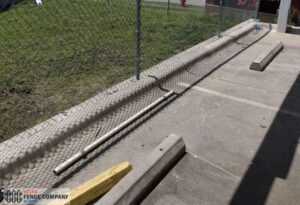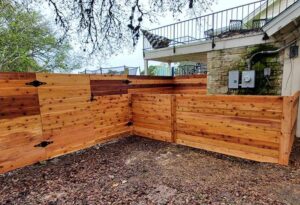How to Repair a Leaning Fence in Austin: A Step-by-Step Guide
A leaning fence in Austin is a common fence problem that many homeowners face, often requiring prompt attention to restore both the functionality and appearance of the fence. Whether caused by weather, age, or poor installation, addressing this fence problem quickly can prevent further damage and maintain your property’s curb appeal.
TL;DR:
A leaning fence is a common problem for Austin homeowners caused by soil shifting, weather, or poor installation. Addressing a leaning fence quickly can prevent further damage and help maintain the integrity of your fence. This guide explains how to identify the issue, stabilize your fence, and fix it yourself. For larger or necessary repairs, contact Atlas Fence Company for professional help.
Table of Contents
ToggleIntroduction: Why Fences Lean in Austin

If you’ve noticed your fence leaning, you’re not alone. It’s one of the most common fence problems homeowners face in Austin. A leaning fence can impact your property’s security, privacy, and aesthetic appeal. In addition, a damaged or poorly maintained fence can decrease your property value by making your home less attractive and secure. Thankfully, with the right tools and know-how, you can fix the issue and restore your fence to its proper position.
In this guide, we’ll walk you through the step-by-step process of repairing a leaning fence in Austin, and help you determine whether it’s a DIY project or if you need professional assistance. Proper fencing maintenance and repair are essential for Austin homeowners to ensure their fencing remains both functional and visually appealing.
Common Causes of a Leaning Fence in Austin
Before diving into the repair process, it’s important to understand why your fence is leaning. In Austin, there are a few main causes:
- Soil Shifting: Austin’s clay soil can shift significantly due to heavy rain, drought, or the natural expansion and contraction of the earth. This can cause fence posts to lean or sink over time.
- Weak or Rotted Posts: If your fence posts were not set deeply enough or have started to rot, they may become unstable, causing your fence to lean. This is especially common with an old fence, where aging materials are more susceptible to deterioration.
- Weather Damage: Strong winds or heavy storms, common in Austin, can push fences off balance, especially if they weren’t anchored properly.
- Improper Installation: Poor fence installation can lead to leaning over time. Shallowly installed posts or inadequate concrete footings can compromise the structure of the fence and affect its stability.
These issues, if not addressed promptly, can result in significant fence damage.
Understanding the cause of the problem will help you choose the right solution.
Choosing the Right Materials for Fence Repair
Selecting the right materials is a key step in any successful fence repair project, especially in the Austin area where Texas weather can be unpredictable and tough on fences. As an experienced Austin fence company, we know that using the best materials not only extends the life of your fence but also protects your property and enhances curb appeal.
Wood Fences are a classic choice for many Austin homeowners. Cedar and redwood are popular options because they naturally resist rot and insect activity, making them ideal for withstanding the humidity and temperature swings common in Central Texas. Regular maintenance, such as fence staining, helps protect wood from UV damage and weather exposure, ensuring your wood fence remains strong and attractive for years.
Vinyl Fences offer a low-maintenance alternative to wood. They are resistant to moisture, won’t rot or warp, and can handle the intense sun and heavy rains that Austin often experiences. Vinyl is a great option if you want a fence that looks good with minimal upkeep.
Chain Link Fences are known for their durability and affordability. They’re a practical solution for both residential and commercial fence needs, especially if security is a priority. Chain link fences can withstand high winds and shifting soil, making them a reliable choice for the Austin area.
Wrought Iron Fences provide unmatched strength and a timeless look. Wrought iron is highly durable and can handle the challenges of Texas weather, from scorching heat to sudden storms. While they may require occasional maintenance to prevent rust, wrought iron fences add significant value and security to any property.
When planning your fence repair, consider the specific needs of your property, your budget, and the local climate. Choosing the right materials will help ensure your fence stands strong against Austin’s unique weather conditions and continues to protect and beautify your home for years to come. If you’re unsure which material is best for your fence repair, our team at Atlas Fence Company is always here to help with expert advice and quality workmanship.
Step-by-Step Guide to Repair a Leaning Fence
Gather Tools and Materials

Before you start, make sure you have the necessary tools and materials to complete the repair:
- Post hole digger
- Shovel
- Level
- Concrete (for setting posts)
- 2x4s or braces (to hold fence in place)
- Screws or nails (for securing panels)
Assess the Damage
Examine your fence to determine the extent of the damage. Check the fence’s alignment and stability, as a small leaning section may just need a little stabilization, but if several posts are affected, you might need to replace them entirely.
Look for signs of rotting or damage at the base of the posts, as this may indicate that the posts need to be replaced.
Digging and Preparing the Area
To begin the repair, you’ll need to dig around the leaning posts:
- Remove any debris around the leaning post.
- Use a post hole digger to remove dirt around the base of the post to expose it.
- If you notice that the post is rotted or damaged, remove the old post completely. This is especially important for a wooden fence, as issues like rot or termite damage can compromise the entire structure. In many cases, replacing damaged posts is necessary to restore stability.
Stabilizing the Posts
If the post is still sturdy, you can re-straighten it:
- Use a 2×4 or brace to temporarily hold the post in place. If the leaning post is part of a gate, extra care should be taken to ensure the gate remains functional and secure.
- Check the alignment of the post with a level to ensure it is upright and in position.
- Once the post is straight, pour concrete around it to set it firmly in place.
Let the concrete set for at least 24 hours before removing the braces and allowing the fence to settle. After repairs, check all gates for proper alignment and stability to maintain the security and functionality of your fencing system.
Installing New Posts (if Necessary)
If the posts are rotted or severely damaged, they need to be replaced. If multiple posts are damaged, a full replacement of that section may be necessary:
- Dig a new hole and install a new post using the same process.
- Make sure the new post is level and aligned before securing it in place with concrete.
Once the posts are securely set, you can re-attach the fence panels. Replacements of posts and panels can restore the fence’s integrity.
When to Call a Professional for Fence Repair
While small repairs are manageable for many homeowners, there are times when it’s best to call a professional fence repair company for comprehensive fence services, including repair, installation, and maintenance:

- If multiple posts are leaning or damaged.
- If you are unsure about the structural integrity of the fence.
- If the leaning is caused by a severe foundation problem or extensive soil shifting.
- If you lack the necessary tools or experience to handle the job safely and effectively.
At Atlas Fence Company, our experienced team specializes in professional fence repair and a full range of fence services. We ensure high-quality results and are committed to providing reliable service and customer satisfaction. Before starting any work, we provide an accurate estimate so you can make informed decisions. For your peace of mind, Atlas Fence Company is fully insured. As part of our maintenance services, we offer professional staining to protect and enhance your fence. We recommend re-staining your fence every few years to maintain its appearance and durability.
Conclusion: Get Your Fence Back in Shape with Atlas Fence Company
A leaning fence doesn’t have to be a permanent issue. With the right approach and tools, you can repair your fence and ensure it remains secure and upright. However, if the job feels too complex or time-consuming, don’t hesitate to reach out to Atlas Fence Company for professional assistance. We can help with any fence project, from repairs to full replacement, and offer both replacement and new fence installation services. A new fence can enhance the natural beauty of your property while protecting your investment for years to come. Our commitment to quality craftsmanship ensures your fence will be durable, attractive, and built to last. We provide expert fence repair services in Austin and the surrounding areas.
📞 Call us at (512) 366-8108 or Get Your Free Estimate today!
FAQs
How do I know if my fence needs repair?
Signs of a leaning fence include visible tilt, gaps between panels, and posts that are loose or rotted.
Can I fix a leaning fence myself?
If the damage is minimal, you may be able to straighten the posts and secure them. However, for more extensive issues, it’s best to consult a professional.
How long does it take to fix a leaning fence?
Repairs typically take a few hours for small issues, but larger projects may take up to a day, especially if posts need to be replaced.
